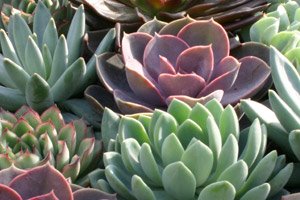
Echeverias are more tender, originating from the New World; from southern
A major difference between these two genuses is that Echeverias are polycarpic, meaning that they do not die once they have flowered. This genus produce rather large (in proportion to the plants themselves) bell shaped flowers that range in colour from yellow and orange to deep red. They flower
Echeverias are not as hardy as Sempervivums, not tolerating the cold well. Most temperatures below freezing will damage or kill them. They are also very sensitive to over watering; their roots must be in free draining soil. They do not like water on their leaves. Care should be used when handling certain Echeverias, as oil from one’s hands can leave marks on their leaves. Light is also essential for this genus, plants growing in low light will be tall and spindly, suffering from etoilation (lack of light).

No comments:
Post a Comment